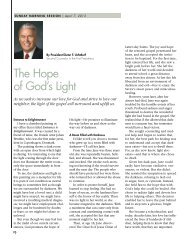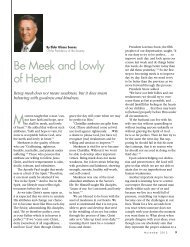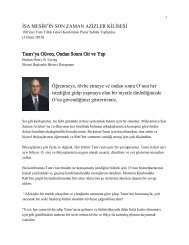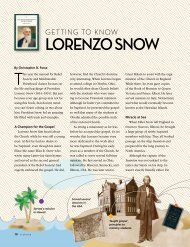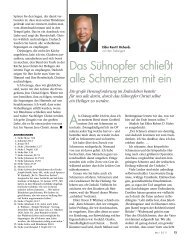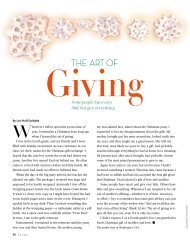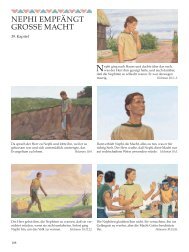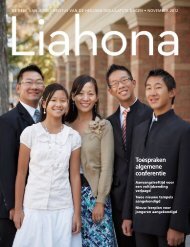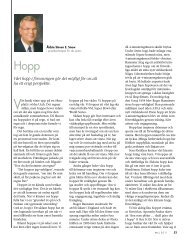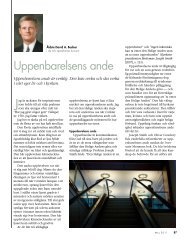February 2012 Ensign - The Church of Jesus Christ of Latter-day ...
February 2012 Ensign - The Church of Jesus Christ of Latter-day ...
February 2012 Ensign - The Church of Jesus Christ of Latter-day ...
Create successful ePaper yourself
Turn your PDF publications into a flip-book with our unique Google optimized e-Paper software.
Emily S. and her four-yearold<br />
son, Landon, who has<br />
pervasive developmental<br />
disorder, talk with Primary<br />
president Debra Malo<strong>of</strong><br />
about things Landon likes<br />
and successful strategies<br />
for teaching him. Serving a<br />
child with disabilities can<br />
best happen when the child<br />
and his or her parents<br />
and leaders work together<br />
in a spirit <strong>of</strong> unity and<br />
cooperation.<br />
After exploring the website, teachers and leaders can<br />
meet again with the child’s parents to share ideas, discuss<br />
concerns, and set goals. Parents can share information<br />
about their child that will help teachers be successful,<br />
such as insights on how the child communicates, which<br />
activities she enjoys and which to avoid, and how to<br />
encourage appropriate behavior. Working with parents is<br />
vital in establishing the unity, cooperation, and ongoing<br />
dialogue necessary to best serve a child with disabilities.<br />
Teachers and leaders should also consult with their<br />
priesthood leaders as they develop ways to serve the child.<br />
When our son was first diagnosed with autism, we didn’t<br />
know how well he was going to transition from nursery to a<br />
Primary class with his peers. A sister in our ward who was a<br />
schoolteacher approached our bishop and Primary president<br />
and <strong>of</strong>fered to be our son’s aide. <strong>The</strong> Primary president, a<br />
member <strong>of</strong> the bishopric, my husband, and I met with her,<br />
and she talked to us about how to help our son. We set<br />
goals and created a plan to help him understand the routine<br />
<strong>of</strong> Primary. We <strong>of</strong>ten needed to tweak the plan over the<br />
following three years, but as he learned to understand what<br />
was happening around him, he became more interested<br />
in interacting with his peers and participating in the lessons.<br />
This sister’s understanding and commitment built the<br />
foundation on which our son continues to stand. Her love<br />
and friendship taught him that he’s a beloved child <strong>of</strong> God.<br />
58 <strong>Ensign</strong><br />
Because <strong>of</strong> that, he continues to see church as somewhere<br />
he can go to be himself and be loved.<br />
Build Friendship and Trust<br />
As teachers we can “follow the Savior’s example <strong>of</strong><br />
<strong>of</strong>fering hope, understanding, and love to those who have<br />
disabilities.” 3 As we show genuine interest in children with<br />
disabilities, our friendship with them will grow.<br />
Children with cognitive disabilities may communicate<br />
differently than others. When teachers tap into a child’s<br />
individual communication style, they are able to build trust<br />
and friendship and become more effective instructors.<br />
Here are two ways to improve communication:<br />
• Put your face at the child’s level. 4 When adults do<br />
this, the child feels less intimidated and more included. It<br />
also helps children who have a difficult time focusing in a<br />
group setting. <strong>The</strong> teacher or aide can capture the child’s<br />
attention and share a sentence or two about the lesson<br />
periodically during the class.<br />
• Find out the child’s interests. Children feel valued<br />
when others show interest in things they love. Children<br />
with disabilities <strong>of</strong>ten become attached to certain things,<br />
such as a particular toy, animal, or game. A teacher can ask<br />
the child to talk about his interests and refer to that interest<br />
in the lesson. Even if the child does not speak, the teacher<br />
can still talk about what interests him.



